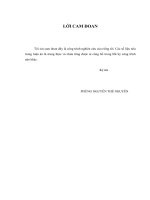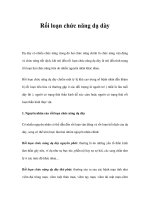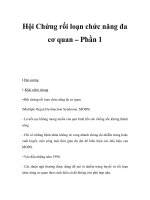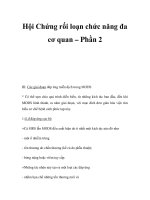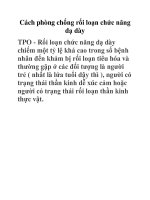Chụp cắt lớp xoắn ốc đa lát cắt trong đánh giá rối loạn chức năng van tim nhân tạo
Bạn đang xem bản rút gọn của tài liệu. Xem và tải ngay bản đầy đủ của tài liệu tại đây (1.06 MB, 29 trang )
MEDIC
MSCT in the Evaluation of Prosthetic
Heart Valves Dysfunction
Nguyen Xuan Trinh, MD
Prof. Pham Nguyen Vinh, MD
Department of Cardiology- Medic Medical Center
Prosthetic Heart Valve (PHV)
MEDIC
In 2003, approximately 290,000 patients worldwide
underwent heart-valve replacement and received a
Prosthetic heart valve (PHV).
( Jesse Habets. Computed Tomography of Prosthetic Heart Valves. 2012 )
Type of Prosthetic Heart Valves (PHV)
MEDIC
Mechanical PHV
Biological PHV
PHV Dysfunction
MEDIC
PHV dysfunction is a rare, but potentially
life-threatening complication.
In clinical practice, PHV dysfunction poses a
diagnostic dilemma.
( Jesse Habets. Computed Tomography of Prosthetic Heart Valves. 2012 )
PHV Dysfunction
MEDIC
Structural valve dysfunction: degeneration, wear,
fracture, and disc escape.
Nonstructural dysfunction: pannus formation , paravalvular
leak, inappropriate sizing or positioning of the PHV, residual leak
or obstruction after valve implantation
( Jesse Habets. Computed Tomography of Prosthetic Heart Valves. 2012 )
Imaging techniques
MEDIC
Have a key role in PHV assessment and the detection of
PHV dysfunction: TTE, TEE, 3D-TEE and fluoroscopy.
Echocardiography and fluoroscopy are the imaging
techniques of choice and are routinely used in daily
practice.
These techniques sometimes fail to determine the
specific cause of PHV dysfunction.
( Jesse Habets. Computed Tomography of Prosthetic Heart Valves. 2012 )
Imaging techniques
MEDIC
Over the past 2 years, MSCT also has shown potential for
PHV assessment.
MSCT can be of additional value in diagnosing the specific
cause of PHV dysfunction and provides valuable
complementary information for surgical planning in case of
reoperation.
Cardiac MRI has limited value in the evaluation of
biological PHV dysfunction.
( Jesse Habets. Computed Tomography of Prosthetic Heart Valves. 2012 )
Evaluation of Native or Prosthetic Valves
MEDIC
MEDIC
MSCT
With Mechanical PHV, opening and closing angles can be
measured as accurately as with fluoroscopy.
Biological leaflet thickening or calcification and leaflet
restriction can also be detected.
( Jesse Habets. Computed Tomography of Prosthetic Heart Valves. 2012 )
MEDIC
Residual opening angle
(normal limit ≤ 20°)-MSCT
(Tsai et al. AJR 2011; 196:353–360)
MSCT
MEDIC
Promising technique to localize the anatomical
abnormalities causing PHV obstruction (Pannus).
Enable the differentiation between a pannus and
a thrombus on density
( Jesse Habets. Computed Tomography of Prosthetic Heart Valves. 2012 )
Disadvantages of MSCT
MEDIC
Radiation exposure
640 slice- MSCT: lower radiation doses
Need for contrast injection.
Morbidity and mortality associated with PHV
dysfunction is high and MSCT can help to establish the
exact cause of the dysfunction
Mechanical PHV Obstruction
MEDIC
A life-threatening complication
Caused by thrombosis, pannus formation, interference by
sutures, infectious vegetations and structural PHV
dysfunction.
( Jesse Habets. Computed Tomography of Prosthetic Heart Valves. 2012 )
Pannus Imaging
MEDIC
( Amal Ibrahim Khalifa, M.D. Assessment of Prosthetic Valves Prosthetic Malfunction. 3/18/2013)
PHV thrombus
MEDIC
( Jonathan Chan et al. Circulation. 2009;120:1933-1934 )
Suggested Non-invasive Imaging Protocol in
the Diagnostic Suspected PHV dysfunction
MEDIC
( Jesse Habets. Computed Tomography of Prosthetic Heart Valves. 2012 )
Biological PHV dysfunction
MEDIC
Most notably, biological PHVs degenerate after a variable time
period (10–20 years).
TTE and TEE are the preferred imaging techniques to assess
biological PHV dysfunction, but both techniques can fail to identify
the exact cause of the PHV obstruction.
Cardiac MRI and MSCT can have complementary value, especially
by identifying pannus tissue or subvalvular obstruction
( Jesse Habets. Computed Tomography of Prosthetic Heart Valves. 2012 )
MEDIC
Case 1
45F, Mechanical AVR and MVR (2009),
MV Prosthesis were stuck ( 2 times).
Mechanical AVR and Bio-Prosthetic MV (2009)
Anticoagulation had been discontinued.
Upon admission: increased Grd peak/ mean across the
aortic valve: 74/33mmHg
TTE, TEE, Fluoroscopy, 640-slice MSCT suggestive of prosthetic
valve dysfunction ( Pannus or Thrombus).
Residual Opening Angle
MEDIC
MSCT Imaging of Mechanical Aortic Valveposterior leaflet restriction
MEDIC
Pannus Imaging
MEDIC
MEDIC
MOVIE 1
MEDIC
Case 2
62M, Bio-Prosthetic AVR (2011)
Irregular check up.
Upon admission: increased Grd peak / mean across the
aortic valve: 220/140mmHg
TTE, TEE suggestive of prosthetic valve dysfunction (
Subvalvular mass ?)
640-slice MSCT suggestive of prosthetic valve dysfunction (
leaflet restriction, biological PHVs degenerate ) and severe
paravalvular calcification
Reoperative repair : 12/ 2013
MEDIC
Biological PHV
Thickening and
Degenerate
MEDIC
Biological PHV Thickening and
Degenerate- leaflet restriction

